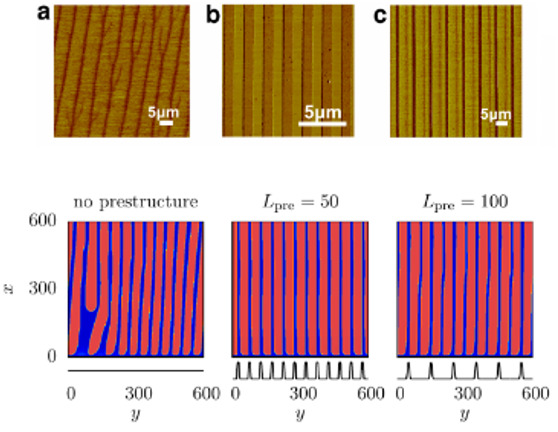Evolution of surface geometries by self-assembly
Open systems far from equilibrium are capable to spontaneously form temporal, spatial, spatiotemporal and functional structures. Examples include hydrodynamic instabilities, chemical reactions at diffusion as well as laser systems. Dissipative self-assembly processes play a central role in growth processes of both the non-living and the living nature. In this context, dynamic processes within the cytoskeleton of a single cell involving changes of the cell surface, but also growth processes and morphological instabilities of cell associations, like the tumor growth, are important to mention.
The working group ‘self-assembly and complexity’ at the Institute for Theoretical Physics of the WWU Münster deals with the theory of the emergence of spatiotemporal ordered structures, the origin of temporal complexity and chaos, as well as the analysis of turbulent fields. The main focus lies on the investigation of the universal properties of structure formation and its theoretical analysis by methods of non-linear dynamics (bifurcation theory, chaos theory and theory of partial differential equations) and statistical physics (stochastic processes, non-equilibrium statistics).
In many cases the dynamics of complex liquids and soft matter is interface-dominated, i.e., controlled by capillarity and/or wettability. Examples include (driven) droplets on homo- and heterogeneous substrates, (active) liquid crystals and colloidal suspensions, self-propelled droplets, and multicomponent multilayer. An important objective is to understand the structure-forming interaction of the various interdependent advective and diffusive transport processes and phase transitions.
Experimental techniques like Langmuir--Blodgett transfer where a surfactant layer is transferred from a bath onto a plate, dip-coating or vapor deposition are widely used to create coatings of a precise thickness and/or structure. Using the self-assembly of microscopic building blocks into macroscopic structures facilitates the production of coatings with highly regular patterns over large areas. One aim is to understand how the basic properties of each system lead to the formation of particular functional patterns, as this allows one to develop ways to control the patterning process, e.g., by means of prestructured substrates or external fields.


